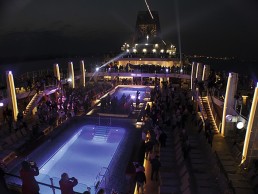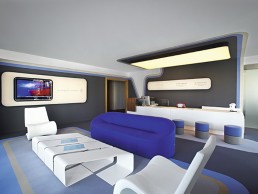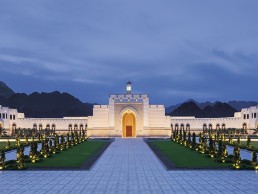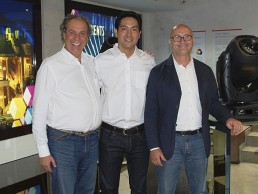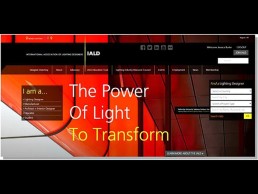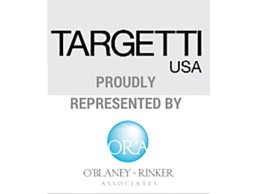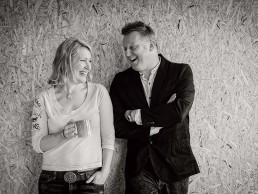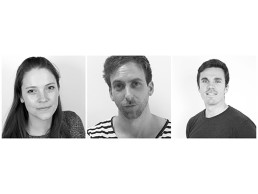Szczecin Philharmonic Hall, Poland
Influenced by the steeply pitched roofs and the verticality of the city’s residential buildings, Szczecin Philharmonic Hall is identified by the monumentality of the upright ornaments of its neo-Gothic churches and the heavy volumes of its Classicist buildings.
Designed by Barcelona-based Estudio Barozzi Veiga with an expressionist mindset, the architectural practice aimed to use geometry to give shape to a new rhythmic composition that conveys feelings by balancing massiveness and verticality. The use of glass as the exterior cladding material highlights how the building contrasts with the conditions of its surrounding environment. It creates a bright, transparent and upstanding object that has been the perfect canvas for architectural lighting design practice Anoche, again from Barcelona.
The design of the Philharmonic Hall goes hand-in-hand with attempts to revitalise the city and restart it as a lively hub with cultural attractions of reference. It is a new interpretation of what were the main attractions of the city, harshly treated by a history of crises and world wars.
The interior of the building showcases the main hall, with everything focused on its needs and on facilitating the movement of spectators and the work of music professionals.
Its overall intention is to reproduce a traditional Baroque music hall, maintaining the typically warm atmosphere inside but with the architects' own vision and a new reading of the form.
All this is brought together in a single building, designed and intended only for music, cloaking the interior neutrality with an expressive façade inspired by the profile of the city itself, whilst transmitting the necessary personality to mirror the city’s identity.
With this achieved by the distinguishable shapes and colours, the music hall has become a new city landmark. The façade is translucent to allow its night-time expression by lighting its white glass with marked vertical profiles. The backlighting of the façade adapts to different moments prior to concerts, heralding their proximity with staggered phases of intensity, in a nod to the ringing of the bells in ancient temples. The start of the concert is announced with maximum intensity of white light. This announcement, silent and stylish, is part of a broader communication repertoire that the building and the façade provide to music and the city. In fact, the LED lighting system allows for all kinds of configurations, sequences and colours, even though the project specified and required only an expression in white.
The dynamic LED lighting solution contains over 25,000 customised Traxon Dot XL-3 RGB fixtures which replaced the originally planned linear fluorescent lamp arrangement. Mounted on flexible strings between the walls of the building and its glass covering, the reflected light emerges from the empty space. e:cue’s control systems manage the installation, with a combination of the Lighting Control Engine 2 fx, Butler XT, and Video Micro Converter delivering pre-programmed content.
There are dynamic and static scenes available for festive days like Independence Day, Anniversary of the Constitution, and Christmas, as well as scenes for special events, concerts, and regular days. The façade illumination starts at the end of the day via the sunrise trigger and stops at midnight, and manual operation is also available via a Glass Touch terminal. By entering a special combination, the Glass Touch is deactivated and the system returns to the sunrise trigger operation. Functionality is monitored by a temperature sensor which automatically switches off the illumination if necessary.
Inside, the uniformity of its white walls, floors and ceilings meant that cluttering the space with visible luminaires was out of the question. Therefore light appears not as a lead actor but as a messenger for the main medium: architecture. It is maximum result with minimal intervention.
The largest area in the building is the Space Hall - giant, transcendent, expressive, neutral and empty. The entire message is offered and communicated there, opening up as a vast meeting point including a cafeteria, where human coming-and-going flows towards the points of attention - the box office, cloakroom, stairs to the main hall, spiral staircase and the cafeteria itself. These spaces, lit as small and open alcoves, express their human concentration by giving off a more welcoming atmosphere and warm lighting that identifies and showcases them.
The lighting fulfils its original function: to show, to lead and to disappear. A major technological challenge, which was achieved by using ERCO 4,000K LED technology for general lighting, was to concentrate overhead lighting with very intensive narrow spots (NSP) from a height of over 25-metres, managing to avoid illuminating the walls surrounding the space.
The use of technology accompanies visitors on the journey to the movement areas of the hall, where the use of metal-halide downlights (also in neutral light, 4,000K) of between 20W and 35W with very extensive WW optics, helps the feeling of volume in these spaces to reach the walls. This becomes visible to help the user detect the change in scale and prepare them to enter the rooms.
Having crossed the gigantic lobby, long staircases close in, changing the scale and preparing the visitor to reach the main hall. A prior area is used to acclimatise the eyes, which is achieved with a transitional space in which pupils can dilate and grow, a black space with very low lighting. This dilation of pupils allows the visitor to arrive in perfect conditions for the surprise to be even greater upon discovering the golden heart of the building.
The main concert hall is lit from above, with 3,000K halogen projectors with intensive narrow spots to gain height and ensure that light reaches the stalls. This overhead lighting helps the visitor better understand the space by showing its brightness and textures. 3,000K LED spotlights, integrated into the geometry of the walls in such a way that they are not seen by users and appear to be reflections of light, are also used to reinforce this luminous discourse of brightness and texture.
The concert hall is also equipped with controls at each point of light, so that the different scenes can be programmed according to needs (welcome, concert, accompaniment, maintenance, for example).
The small concert hall, all black, stands out for the use of neutral 4,000K lighting to showcase the space. The integration of points of light on the ceiling is absolute, and this regulation makes its versatility total at all times. Circulation areas in the room are resolved with more intensive NSP lights so as not to cast light on the walls, which in turn are lit by 4,000K LED points near the floor to provide a sense of security during periods of low light intensity.
The remaining areas of the building harmonise naturally with the main lighting concept, adapting to the tighter budget that these areas receive. The dressing rooms, rehearsal rooms and public bathrooms strive towards practical and integrated lighting, in this case with linear or compact fluorescents, always with warm 3,000K light as they are areas of use, drawing from the architecture to prove integrated and functional.
Szczecin Philharmonic is the new icon of the city and darling of the architectural world thanks to its form and it's spectacular lighting. Following it's inauguration in September 2014 it has won a plethora of architecture awards including the coveted European Union Prize for Contemporary Architecture – Mies van der Rohe Award 2015 in May.
HOME, UK
As one of the host venues for this year’s Manchester International Festival (MIF) and co-producer of festival performance Neck of the Woods, HOME is the latest cultural destination to hit the streets of one of the UK’s most vibrant cities.
Featuring international contemporary art, theatre and film, HOME is a bold new centre that commissions, produces and presents a provocative year-round artistic programme and is a space in which artists can create work that interrogates and illuminates our existence and experiences today. Having received a cool £25m investment - with contributions coming from Manchester City Council, the Arts Council England Lottery funding and fundraising including £250,000 from Garfield Weston Foundation and £150,000 from The Granada Foundation - the new space forms the cultural heart of the First Street Redevelopment project in Manchester and it is anticipated that the venue will attract half a million visits a year, making significant economic and social impact to the local and regional economy.
The overall design for HOME was led by Dutch architectural practice Mecanoo, while Wates Construction led the design team, which included Buro Happold Engineering, Concrete Amsterdam, Space Group and Charcoalblue.HOME features a 500-seat theatre; a 150-seat flexible theatre; a 500m², four-metre high gallery space; five cinema screens; digital production and broadcast facilities; as well as a café bar and restaurant. With its roots in two of Manchester’s best-loved cultural organisations, Cornerhouse and the Library Theatre Company, HOME will inherit and build upon these artistic legacies, with artistic directors Sarah Perks, Walter Meierjohann and Jason Wood leading a dynamic in-house team, while working with international networks, curators, designers, playwrights, directors and artists to commission, guide and produce the year-round programme.
Commenting on the direction of this new cultural hub, Dave Moutrey, Chief Executive, said: “We’ll be a 'home' for everyone, staging challenging and critically engaged art, yet connected with our city. We exist to produce outstanding art, create unforgettable experiences, develop skills and make a difference to people’s lives.”
The ‘home for all’ ethos is reflected in the building’s characteristics. Its striking exterior acting as a beacon, while welcoming public spaces and social areas designed in such a way that HOME is inviting to all - a place for making, meeting and socialising. For Mecanoo, working alongside BuroHappold Engineering, identity was key. From the outside, the building’s triangular shape and rounded corners create a strong visual identity. The building, which connects the First Street zone with the city centre, is carefully positioned in its surroundings while visually distinct from the adjacent, commercial developments.
The glazed façade, adorned with irregularly spaced fins, opens up where public areas are located, giving the building a varied and dynamic appearance. The iridescent façade reflects the surrounding city and skies, its colour changing from black to blue to green depending on the weather.
Mecanoo partner Francesco Veenstra commented: “We tried to perforate the façade as much as possible to let daylight into the building, especially in the main entrance.” At night, the building comes alive with help from 65, five-metre Aurora LED strips, neatly tucked in all the way around, illuminating the building’s exterior. At the same time, from inside the lighting acts very much as an attractor at night - the building viewed as a lantern - creating a warm and inviting quality throughout.
Putting the visitor at the heart of the project, BuroHappold provided multi-disciplinary engineering solutions from the ground up. Partner Mark Phillip explained why it was so exciting to be part of the project: “HOME provides a fantastic new cultural hub for Manchester’s community and through the building’s design, this vision has really been brought to life.”
“HOME is quite a demanding space where a lot happens in a small area,” added Laura Phillips, Head of Lighting at BuroHappold. “The material palette adds a lot of drama to the space and from a lighting perspective provides challenges in terms of sufficient visual brightness and bringing out the inherent qualities of the materials used. With the use of the building always in mind, we played with the idea of light and dark. Different lighting languages help to define the different uses and assist with visually organising the space.”
The relationship between natural and artificial light at HOME was, of course, a key consideration as Phillips went on to explain: “Sunlight is allowed into the building in a controlled way and adds drama and visual interest to the various spaces. The lighting was mindful of the transmission from inside to out, where people would be leaving the theatre environment to move outside and so, to help with this, the lighting is at a slightly higher level at the entrance spaces.”
A series of sensors have been fitted at HOME to respond to daylight levels - increasing and decreasing the artificial lighting accordingly. Veenstra commented on the use of daylight in the space: “We deliberately opened up the southern corner to let as much daylight through as possible. The brief was to create an open appearance when you’re looking out from the building, but also when looking into it. It’s not pretentious… The quality of daylight comes from a large window format, four-metre high pieces of glass, at 1.5-metre intervals. The daylight then falls into the deepest part of the floor, reducing the amount of artificial light needed.”
Inside, intimacy is key with the triangular floor plan allowing for a series of unique rooms inhabited within the three corners, including one of the five cinemas. On entering HOME, a combination of suspended and recessed Whitecroft fixtures; suspended Illuma Concepta fixtures; Chelsom decorative glass black pendants; and Inspired By Design bespoke decorative lamps, work within the urban living room layout to instil a sense of warmth.
Very raw materials have been used as much as possible at HOME. Wood and steel are the main ingredients and part of this is a large central wooden stairwell, which acts as the main circulation route through the building - helping to create a strong sense of identity, as Veenstra explained: “For such a dense building, inside we introduced this big staircase bringing people from the ground floor, through the first and up to the second. Covered in wood, which will colour in time through exposure to daylight, it becomes the heart of the building.”
The stairwell makes use of suspended Whitecroft Mirage SX and Illuma Concepta fixtures all the way up - connecting the different aspects of the venue: gallery (also on the ground floor and featuring ERCO Optec fixtures), theatres one and two (featuring GDS Blue Dome and Pro 1, 4 & 8 Cell fixtures) and cinema. According to Veenstra, The decision to use suspended lighting fixtures, rather than hiding everything away, came from the idea of using the building as a machine. Mecanoo’s Ernst ter Horst explained further: “It’s an honest approach that keeps costs down while achieving so many goals. The concrete is exposed and celebrated and the lighting really helps with this.”
The bars and restaurant are located in the areas in between, some of them cleverly integrated into the characteristic stairwell; the restaurant is an essential part of the integrated art and culture concept, with high floor-to-ceiling windows - Chelsom glass black pendant lights and custom made fixtures from Inspired By Design, again create an airy and inviting space. As you move up to the second floor, the roof terrace offers a view onto the square - the rugged concrete floors and part of the walls contrast with the warm oak of the bar.
With the lighting more or less replicated on each floor of HOME, Phillips told mondo*arc of HOME's lighting brief: “The space was to feel pared back, yet warm and comfortable so lighting was important to create warmth and to direct visitors on the use of different spaces. Early on in the process we established the importance of vertical illumination to key surfaces in order to create a sense of enclosure and comfort to the bar lounge areas.”
Horst adds to this: “The Cornerhouse wasn’t about having fancy lighting features, it was about being honest and appropriate lighting - we didn’t want HOME to be glaring – but still get warm lighting, a nice downwash on the timbers. The fixtures point to the plywood to celebrate the material and shiny concrete floor - celebrating the palette of materials and elements we have in the building. It has been kept very simple from an architectural point of view, but also from a light point of view.”
Summing up the experience of HOME and the challenges the BuroHappold team faced, Phillips concluded: “Brainstorming ideas with Mecanoo was really great fun and then seeing those ideas come together on site was very satisfying. It was important to consider the technical requirements, especially for darker spaces such as the cinema and theatre where there are changes of level, but this did not drive the design. We looked to create the right quality of lighting for how people will use each space, then looked at how the spaces could be stitched together with down lighting and wall washing to provide continuity and assist with orientation.”
As remarked by Councillor Rosa Battle, Executive Member Culture and Leisure Manchester City Council: “The opening of HOME marks the newest high-profile addition to Manchester’s renowned cultural scene - a scene that brings with it huge economic benefits and is a big part of what makes the city a place that people want to live, work and invest in."
Britannia Cruise Ship, UK
The Britannia P&O cruise liner began its journey in mid-2011 when the MBLD team joined interior designers Richmond International to change the face of cruise ship design. P&0 presented a brief which challenged us to develop a completely fresh and contemporary approach, which would, at the date of launching in March 2015, be introduced on Britain’s largest cruise ship.
As well as a new aesthetic, energy consumption was at the top of P&O’s priorities. With this in mind, the use of LEDs to reduce energy connsumption compared with traditionally used halogen sources was, from the outset, a goal which we worked hard to achieve, given the added issues of vibration and unstable power when using LEDs on a ship.
From the outset, we were required to meet targets for each of the public areas, in terms of loading and dimming circuits. Based on experiences from other ships' use of halogen downlights, we felt confident it could reduce the ships loading. By turning the ship into a fully LED lit scheme the energy consumption was reduced to a third or less of its normal running requirements. This, along with our approach to luxury hospitality lighting - whereby lighting is selective and sensitive to each area - has seen significant improvements to the energy demand on the ship.
While ship specification and stringent space-by-space requirements provided benefits in some aspects, it took away from others in terms of the limited number of circuits allowed within each space. This meant that we had to work hard to achieve the balance of lighting within each space; a task that proved challenging in areas such as large scale restaurants or zones that consisted of mixed use spaces, yet shared limited circuitry.
Working closely with the lighting manufacturers, we selected products and LED chips that ensured consistency in the quality of light and colour temperatures across the range of 130 lighting products installed. Public area lighting was supplied by Ensto Italia and Cabins by iVela, Italian manufacturers that have had many years experience working with the Italian shipyard Fincantieri.
The aim was to develop a range of products that would allow the least amount of variations for difficulties faced in maintaining lighting whilst at sea and provide the best design pallet to cover all aspects of the wide range of spaces across the ship. Catering for 3,600 passengers, across fifteen passenger decks, the 1,082ft ships consists of thirteen bars, thirteen restaurants and cafes, a spa, theatre, TV studio, dance hall, specialist cookery school and pool decks. At the heart of it all is the atrium - comprised of celebrity bars, delis and the focal lighting installation called the Starburst - the concept of Richmond International, developed by Jona Hoad Design. The Starburst, made up of 300 illuminated shards and 200 hand finished triangular facets, creates a spectacular centrepiece that elegantly explodes and drops seven metres from the ceiling, floating above the lower deck.
Working together with Jona Hoad Design, we developed a lighting narrative that created a dynamic and adaptable lighting sculpture. The piece is programmed with eight lighting scenes that utilise the 580 individual 2W LEDs within each of the acrylic shards over 72 DMX channels and eighteen Lumenbeam RGBW floodlights focused onto the Starburst.
The welcoming scene is of gently pulsing shards combined with floodlighting of red, white and blue, creating a ceremonious Union Jack like arrival onto the Britannia. The day-to-day scene works with the ship's clock, displaying a warm golden colour in the morning through to a darker moody aubergine colour in the evening, with an on-the-hour light explosion, when the shards chase up the Starburst and sparkle across the ceiling.
With the Starburst providing a statement attraction, the lighting within the rest of the three-storey high space was carefully balanced to provide the ground floor seating area with a vibrant and comfortable setting. The surrounding levels include four individual bars across two floors, a retail floor and another central feature at a spiral staircase with individually lit acrylic balustrade rods. Other striking areas include Olly Smith's The Glasshouse on deck seven, sparkling with four glass chandeliers and backlit bar counter.
Lighting played an important role in continuing the experience through transitional spaces. Scene-setting between night club venue to signature restaurant, retail units and spa required the balance of light which one would expect.
The Lime Light Lounge - where entertainers such as Jaki Graham and Kiki Dee performed in a laidback jazz club atmosphere - features a central lighting feature providing an adaptable and attractive detail within the otherwise low key lighting. The 150 programmable LEDs, with four different coloured handmade amber glass diffusers linked to a DMX system, were set to slowly ripple across the ceiling during dining followed by a more dynamic effect during the late evening setting. All of which links back to the entertainment AMX control system to adapt to the flexible performance space.
The rest of the lighting is muted with selective gimbal downlighting to tables, highlights from golden pendants and pin spots to provide sparkle from the feature wall glass beading details creating an opulent and atmospheric dining and entertainment space.
At the other end of the scale, a large theatre, one of P&Os largest and advanced venues to date, features full video wall mapping. With a contemporary take on traditional theatre design, specially developed adjustable high power LED downlights ranging from wide to narrow beams were integrated within ceiling trough details, splaying out in a radial arrangement across the ceiling rafts to provide the house lighting.
On the other hand, wall panelling details lended themselves to a linear framing detail completed with uplighting to a central copper panel, creating the perfect low level ambiance for show settings.
Special areas for the cruise liner include the Open Decks and the new James Martin cookery school. The Open Decks were considered as a place for entertainment lighting to take control during the hours of darkness. We were briefed to develop this, working in harmony with the entertainment lighting to create an extra special night time venue. Lighting control for the first time was seen as a vital part of this area although limitations were to be considered within the ship specification. With this in mind, we set about selectively integrating feature lighting within architectural elements, such as the pool edge, planters and large scale pylons which house entertainment speakers and moving head projectors.
The scenes set for the different areas include: a brighter and radiant surrounding for the terrace pool, more intimate and relaxing setting for the serenity pool and bar and a golden and vivid lighting scheme to highlight the entire perimeter of the lido pool. One of our lighting designers, Arianna Ghezzi, commented: “Our intention was to bring a Miami Beach pool party feeling to the Britannia poolside, creating a glamorous experience for the guests, supporting with our different lighting settings the various events the entertainment has scheduled.”
The cookery school, which was to be offered as a working professional kitchen for small classes of people learning from chefs, had the function of a private dining space open to the kitchen added. Lighting within the kitchen area had to meet lighting requirements of a working kitchen whilst forming the backdrop when not in use for the dining area, with the head chef table set as a part of theatre for the on-looking diners.
After four intensive years the day came for the MBLD team - Laura Mackay and Arianna Ghezzi, along with support from Rebecca Hines, Rob Honeywill and two Helvar technicians - to prepare for the final commissioning. After spending one week in the shipyard and one week at sea from Monfalcone to Southampton the ship was launched by Her Royal Highness the Queen at a grand ceremony in Southampton dock where the Britannia was successfully named in full glory of red, white and blue, christened with Wiston Estate English Sparking wine specially selected for the occasion.
Pics courtesy of P&O
New Age Clinic, Turkey
New Age Clinic is a plastic surgery, known for its hair transplantation procedures, located on the twelfth floor of the Fulya Terrace building in Istanbul, Turkey. UÄŸur Ä°mamoÄŸlu and Iglo Architects have created an affordable and impressive design through rational solutions. An impressive interior space was achieved by colouring on the walls, graphic arrangements on the carpet and the design of several furniture and illumination elements.
The founders of the clinic, Dr Ä°lker Apaydın and Dr Özge Ergün, requested a style that would reflect their personality and the job that they do. The existing 250sqm layout, having four rooms and a lobby, was suitable to function as a plastic surgery without any changes.
The clinic has an original, modern and smart design that serves a clientele who value aesthetics. A deliberate avoidance of standard surgery colours - white and blue - was expressed by the decision to use dark grey as the main colour from ceiling to floor. On the ceiling and wall crossings a fluid form was used to mimic a heartbeat. These graphic details help to define the style of furniture, such as the five-metre long desk in the lobby which was designed by Iglo especially for the project.
As no structural elements were desired, ceiling details were enhanced by using specially designed stretch lighting elements. The designer's brief was to create an aesthetic space that makes clients walk in and feel comfortable with the surgeon's work.
Most of the lighting fixtures were designed by Iglo Architects specifically for this project. All illumination in the corridors and lobby is provided by stretch ceiling fixtures, which were made to measure on the spot. On the ceiling and walls, electronically controlled Osram LEDs were fixed to a Barissol PVC stretch ceiling in a metal case.
The fixtures designed by Iglo and produced by Tekno Yapi provided the illumination level needed in the space without the need for additional fixtures. In the office spaces and consultation rooms, Philips wall fixtures, desk lamps and pendants were used for illumination. LED spots, provided by local manufacturers, create a sophisticated effect in the reception via a concealed positioning behind the steel plate on which the New Age Clinic logo was engraved.
A simple, clean approach to the interior and lighting design reflects New Age Clinic's desire for precision and aestheticism.
Pics: Fethi Izan
New Parliament Building, Oman
Oman’s recent civilisation is very visually present in the architecture of the landmark buildings that are spread throughout the country. It is the vision of Sultan Qaboos, the Sultan of Oman, to build a modern civilisation that has its roots in the Islamic arts and culture and this can be best seen in the modern Omani architecture of the low rise buildings in the capital city, Muscat.
The architecture of modern day Oman is unique in the Arab world combining Arab and Islamic culture and heritage with a classic contemporary style. Most of the buildings utilise the simple lines and arches found in the traditional forts and castles together with the precise cutting and carving technologies of the modern day to create some of the most magnificent Islamic architectural sculptures found around the world today. The Royal Opera House, the Grand Mosque and the Allam Palace are examples of this architectural style.
Majlis Oman, the new parliament building, is the latest of these landmark buildings in Muscat. The building comes as a testimony to the Sultan's vision of establishing a modern democratic state built on grounded Islamic routes where the people of the land are an integral part of the decision-making authorities in the country.
The symbolic significance of this project cannot be overstated. The Majlis is at the very heart of Oman's constitutional power and is the only legislative body in Oman where all members are democratically elected.
The building is located in the prestigious Al Bustan area of Oman close to the Ceremonial Palace and Ministerial buildings. The new Majlis overlooks the Gulf of Oman and is surrounded by a mountainous background and primary dual carriageways.
The building's design has a number of elements that are based upon elements from the numerous early forts located throughout Oman. This building both respects the origins and takes from it, and also adapts into a modern Omani style showing the forward looking intents of the government.
Scale is the key to the design of the external spaces. The architectural scale of the Majlis Oman built form is truly grand and monumental and drives the design. This grand and monumental scale is preserved in the landscape. Broad and flexible spaces open views to the architectural façades. These spaces are also designed to accommodate the grandeur and spectacle of ceremonial functions.
The grandeur establishes the Majlis Oman as the symbol of the highest order of national governance. The design of external spaces also provides human scaled spaces within the campus. Trees and palms planted relatively close to the facades transition the scale from monumental to human. Social scaled spaces are created in areas close to buildings. Examples are the two enclosed courtyards, the Clock Tower Courtyard and the Mosque Plaza that are more detailed and intimate spaces for smaller groups or solitary enjoyment of the outdoor environment.
The actual construction of the main building started on 29 July 2009 and was completed on 13 October 2014. The 101,931sq.m site featured a new building to the upper and lower houses of parliament (Majlis Oman, Majlis A’shura and Majlis A’ddowla), VIP areas, an information centre, library and associated offices/facilities to support the buildings.
The concept design of this iconic building started as a design competition that Australian architectural practice Moller Architects won. Detail design was carried out by Oman’s Royal Court of Affairs’ in-house team of architects, designers and engineers with Ammar H. Mohamed (Senior Lighting Engineer) and Anthony Coyle (Coordinating Architect).
The preliminary site enabling works took six months as the site had a hill which was removed and a number of Wadis (water channels) that were diverted away from the project site. Lighting design practice Visual Energy was commissioned by the Royal Court of Affairs to design the façade and landscape lighting for the entire project. The brief was to bring the Majlis alive at night time with the help of artificial lighting to enhance the style and identity of the building.
With over 2km of façade to illuminate, it was by far the largest and most visible element of the project. A number of challenges had to be tackled including finding a solution that was unique, sustainably and economically viable, and would enhance the architectural lines and contours of the highly engineered façade stone work.
During the concept design, two approaches for illuminating the building were studied simultaneously, the first relied on conventional inground metal halide uplights and floodlights and the second was a more revolutionary (at the time) linear in-ground high power LED system that would evenly illuminate the façade. A number of computer models and physical mock-ups at site were made to compare the two systems and to communicate the idea to the architects and the client.
The selected solution had to successfully illuminate the façade so that it could be seen from a minimum distance of 250m away for the public and close-up for the VIP guests and dignitaries visiting the building. From the mock-ups it was very clear that the traditional system of uplights and floodlights (spaced at 6m apart) would not achieve this goal as it resulted in the following adverse effects:
• The carved details in the façade of the building will be flattened out if floodlit from a distance. These details can only be seen when layers of light and shadows are present to emphasise the depth of the grooves in the façade.
• The shadows created by the architectural elements such as arches will not be evenly seen on the building.
• A single burned out lamp will create a gap of 12m of darkness which would be very visible from the viewing platforms created alongside the main roads.
• The VIPs and dignitaries would be affected by the glare from the floodlights as they walk out of the building at night time.
• Due to the low lumen output of LEDs at the time, metal halide floodlighting was not considered viable due to the large amount of power it would consume.
Therefore the selected solution was to project a linear beam of light at a precise distance away from the façade so that the shadows could be controlled. The location of the light fitting had to be closely coordinated with the landscape architects as it would run around the entire building, and coordinated with the architects on the floors above.
The scale of the Majlis dictated that the lighting had to be plentiful, varied in its form and function but beautiful to behold. There was no room for standard products in such grand surroundings. One of the principle terms in the lighting contract as per the Royal Court of Affairs criteria was that lighting manufacturers had to provide a five year limited warranty (due to the extreme heat and dusty conditions) and the qualifying companies must have been running for a minimum of ten years. Working closely with specialist lighting manufacturer Linea Light, Visual Energy designed a custom linear LED recessed in-ground solution that allowed for a small offset from the wall of only 900mm while still maintaining a uniform vertical illumination and minimal glare to the users of the space. The length of the fitting was also customised to be exactly 1,200mm so it could fit into the 4.8m grid used around the building.
Furthermore, the inground casing of the fitting allowed for running the three-phase cables and DMX within the body of the fitting, minimising the number of tapping points from the building, and the depth of the fitting was restricted to 100mm so it fits within the screed and top finish of the flooring. The fittings in the upper terraces were dimmed down to give a continuity effect to the light from the fittings in the ground. Finally a number of metal halide inground uplights were added around the main entrances of the building to emphasise the importance of these entrances when compared to the rest of the building.
Another important decision that was taken during the mock-up stage was the selection of the exact colour temperature of the inground light fittings to best illuminate the two-shade stone cladding of the building. 2,800K was finally selected as the most appropriate colour temperature and was used for all the LED fittings illuminating the façade of the building with the metal halides being 3,000K.
When the building was fully illuminated, the shadow lines were clearly visible as sharp lines seen from the 250m away roundabout and viewing platforms. The building now has a striking night-time façade and landscape set on a backdrop of the rocky Al-Hajar Mountains that can be enjoyed by the local population and visitors to the region alike.
Pics: Adam Parker - www.buildingimages.co.uk
Clay Paky welcomes Alfonso Zarate Takano
(Italy) - Alfonso Zarate Takano appointed as new Clay Paky Area Manager for Asia Pacific region.
Alfonso Zarate Takano is the new Clay Paky Area Manager for the Asia Pacific region (APAC), comprising all countries in the Far East, South Asia and Oceania. Takano will report operationally to Sales Manager Alberico D'Amato, and is based at the OSRAM offices in Singapore.
"The markets in Asia and Oceania are growing fast and the appointment of Alfonso Zarate Takano is a strategic move to ensure a constant fixed local presence," said D'Amato. "It will now be easier for Clay Paky to visit customers in the region and provide top-class timely technical and commercial support."
Takano was born in Peru, but has lived for many years in Japan and Singapore and speaks English, Spanish and Japanese. He has excellent technical experience in the industry, having worked for important manufacturers of stage and architecture lighting, as well as detailed knowledge of customers in the region.
"Clay Paky has the support of a professional with an ideal profile for our business, on a market that will be a primary outlet for our offer," said Clay Paky CEO Pio Nahum.
Takano has already been to Clay Paky for a training course, where he had the opportunity to study the corporate guidelines and all the company products. He has been operational in the region since July 2015, where he has already visited all the main local Clay Paky distributors, with whom he will be working closely to optimise product promotion and marketing.
At his main international appointments, Takano will always be accompanied by a Clay Paky Sales Support Engineer.
IALD launches new website
(USA) - IALD.org is easier to navigate, mobile-friendly and offers reimagined user interface.
The International Association of Lighting Designers (IALD) launched its new online home at IALD.org this month. Redesigned with the lighting community in mind, IALD.org is easier to navigate, with a mobile-friendly design and a reimagined user interface.
UPGRADED LIGHTING DESIGNER PROFILES
The Find a Lighting Designer feature on IALD.org gives you access to redesigned profiles of more than 750 of the world's leading architectural lighting designers.
GLOBAL EVENT CALENDAR
IALD's worldwide network of regions and chapters host some of the industry's most vibrant and unique events. See what IALD is doing near you.
ONLINE MEMBERSHIP APPLICATION
The IALD Membership Committee is pleased to begin accepting applications online. Learn more.
REFRESHED NEWS FEED
Visit the IALD News page for a real-time feed of information about what the IALD and its members are up to; or get a digest of the information by perusing past issues of Reflections or Member Spotlight.
Targetti USA appoints O'Blaney Rinker Associates as NYC representative
(USA) - Manhattan-based boutique design agency will represent both Targetti and DuraLamp lines for New York and surrounding metropolitan areas.
O'Blaney Rinker Associates (ORA) is a boutique design alternative lighting agency that provides services from schematic development through the project completion and after-market service for their clients and manufacturers. The Manhattan-based agency provides lighting and control system specifications and sales, a vast range of experience and knowledge across the complete spectrum of New York's lighting design, engineering, architectural and distribution communities.
Marie Paris, US Business Development Manager said:"The NYC and New Jersey area is a primary specification influence for the global lighting industry, as well as a dynamic market for both our brands. As a premier sales representative in the area, O'Blaney Rinker Associates is uniquely positioned to help us communicate our message and manage our continued growth in the US market."
"We are pleased to be represented by such a top-notch organisation that truly understands the specification community."
Caroline Rinker an ORA Principal said: "We are very excited about our new partnership with such an iconic brand as Targetti. Their history in the international market and focus on quality and innovative solutions provides a perfect mix for our U.S. specification customer base."
Kate Wilkins and Sam Neuman join forces
(UK) - London based lighting designers bring together years of collaboration to create portfolio of varied projects and launch new website.
Lighting designers Kate Wilkins and Sam Neuman have joined forces after years of collaboration. Their new web-site KateandSam.co.uk is now live showing a portfolio of projects of different scales using both well-established and cutting-edge lighting techniques and often together.
Much of their work is about lighting as a way to effectively bring out the materiality and details of both architectural interiors and exteriors. Another of their objectives is based around exploring the narrative role of lighting in a space and a physical and psychological feel-good factor that can be achieved through tactical lighting.
Wilkins and Neuman's interests follow lighting as an essential part of a business' identity. Their work for Wahaca restaurant group has explored the notion of brand in this way. Most recently, Wilkins and Neuman completed the lighting scheme for Wahaca Cardiff. This involved the installation of Booo soft rubber pendants each supplied with a 2,700k 650 lumen LED with mains dimming down to 10%. To work with the colour palette and react to the warmer tone light waves, the pendants were fitted with custom yellow and orange flexes. The Booos help bring the room down to a more friendly scale for dining whilst keeping the impressive size.
The studio has also recently completed the lighting scheme for Llanelly House in Wales (pictured right). The building is Wales' finest Georgian house and has been painstakingly restored for public use, incorporating retail, function rooms, exhibition space and a restaurant.
The studio used a lighting scheme in the grand room that highlights important works of art and architectural details, including the original cornices. The role of lighting in conservation and historic buildings is something that they are looking to explore further in the future.
PNLD announces promotions
(UK) - London based architectural lighting practice promotes senior team members Daniel Blaker, Ellie Coombs and Emilio Hernandez to continue growth.
London based architectural lighting design specialists Paul Nulty Lighting Design (PNLD), have announced the promotion of senior members of the team within the award winning practice.
Daniel Blaker has been promoted to Creative Director, Ellie Coombs takes up the role of Director and Emilio Hernandez takes up the position of Associate. Blaker, Coombs and Hernandez oversee a team of lighting designers and are currently heading up projects including Keflavik airport in Iceland, a roof top park and 5* hotel in central London.
Phil Copland, Anna Clara Sandgren and Christina Hebert have also been promoted to senior designers within the practice.
Paul Nulty, Head of Practice said: "Promotions are a proud time for us as a business. These promotions are well deserved and it signals our maturing as a practice whilst continuing to highlight our intent to employ, nurture and develop the best talent within the industry.''
PNLD is now in its fifth year and has a reputation for high quality and creative design work across the commercial, residential and retail sectors. The team has grown rapidly in the four years since it was founded in 2011 and has tripled in size to 26 employees.
Kingfisher Lighting appoints new MD
(UK) - Chris Claydon-Butler brings experience of technical markets to grow business through customer service and product excellence.
Chris Claydon-Butler joins Kingfisher Lighting, the exterior lighting specialist, as Managing Director and her eyes are firmly fixed on continuing to grow the business by focussing on customer service and product excellence.
Coming from a background of consolidating and growing businesses, Claydon-Butler has a proven track record in technical markets and has worked with a range of customers from some of the world’s biggest blue-chips to independent SMEs.
Claydon-Butler commented: “The recent boom in lighting and LED technology is the talk of board rooms up and down the country. Being able to take Kingfisher to the next level in its development against this backdrop is going to be exciting, challenging and rewarding. Kingfisher has the longevity some lighting businesses lack, but with a desire to do things differently and an open mind. In my opinion that’s the perfect reason to be here.”
Zumtobel opens office in Santiago, Chile
(Chile) - Zumtobel Lighting expands market reach by servicing the region with both European and North American products, services and support.
Zumtobel Lighting, a supplier of lighting solutions, announced today that it has opened a new office in Santiago, Chile to support growth in Latin America. The Zumtobel office in Santiago has the ability to provide lighting solutions to the Latin American market with products easily supplied from Zumtobel locations in the United States and Europe.
Zumtobel has the capacity to support the Latin American region with its 110V product lines from North America, as well as 220V systems from its facilities in Europe.
Zumtobel Lighting, Inc. CEO, Kevin Maddy said: "The opening of the Santiago office to include its sales, distribution, service and support capabilities demonstrates our commitment to grow in the Americas."
Maddy continued: "There was a growing need for our presence in the Latin American market in order to best serve our clients and make ourselves more accessible and responsive to our client's needs."
Led by Managing Director, Pedro Rego and staffed by multilingual staff speaking Spanish, Portuguese, English and German, this office provides sales, distribution, service and support capability throughout Central and South America. Additionally, the Latin American team has the support of Zumtobel Group worldwide including the Key Accounts Team located in Dallas and New York, as well as the International Projects Team in the United States and Austria.




